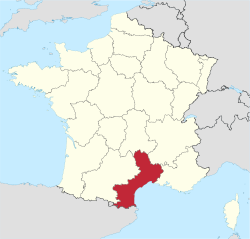Languedoc-Rousillon
| Languedoc-Roussillon | |||
|---|---|---|---|
| Region of France | |||
|
|||
 |
|||
| Country |
|
||
| Prefecture | Montpellier | ||
| Departments | |||
| Government | |||
| • President | Damien Alary (DVG) | ||
| Area | |||
| • Total | 27,376 km2 (10,570 sq mi) | ||
| Population (2012-01-01) | |||
| • Total | 2,700,266 | ||
| • Density | 99/km2 (260/sq mi) | ||
| Time zone | CET (UTC+1) | ||
| • Summer (DST) | CEST (UTC+2) | ||
| ISO 3166 code | FR-K | ||
| GDP (2012) | Ranked 10th | ||
| Total | €63.9 billion (US$82.2 bn) | ||
| Per capita | €23,566 (US$30,311) | ||
| NUTS Region | FR8 | ||
| Website | laregion.fr | ||
Languedoc-Roussillon (French pronunciation: [lɑ̃ɡdɔk ʁusijɔ̃]; Occitan: Lengadòc-Rosselhon; Catalan: Llenguadoc-Rosselló) is a former administrative region of France. Since 1 January 2016, it is part of the new region Occitanie. It comprises five departments, and borders the other French regions of Provence-Alpes-Côte d'Azur, Rhône-Alpes, Auvergne, Midi-Pyrénées on the one side, and Spain, Andorra and the Mediterranean Sea on the other side. It is the southernmost region of mainland France.
The first part of the name of the province of Languedoc-Roussillon is the French language words "langue d'oc", literally "language of oc". In southern France the word for "yes" was the Occitan language word "oc". Prior to the 16th century, the central area of France was referred to as Languedoil, there the word for "yes" was "oil" in Old French, later becoming "oui". These old place names referred to the areas where Occitan was spoken, and Old French was spoken The Edict of Villers-Cotterets made French the official national language in 1539. Roussillon was the name of the medieval County of Roussillon.
The region is made up of the following historical provinces:
...
Wikipedia

